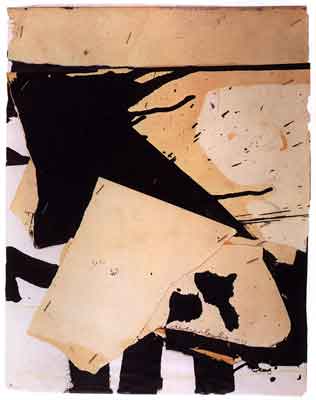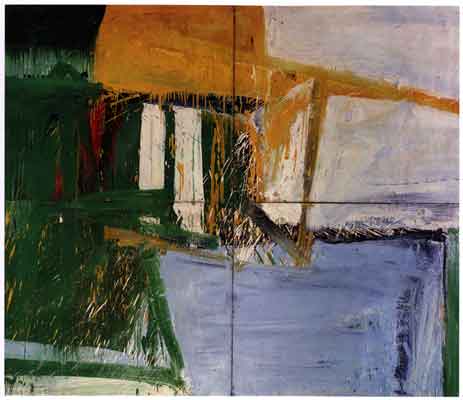| Many of the works, large and
small, are configured in quadrants, as though to satisfy the four sides of the
rectangle, the four sides being taken as points of view, just as the figures
in the later portraits combine face-on perspectives at four different levels.
In Yellow Third, the quadrants partake of the shape of the canvas, but
they also more aggressively interpenetrate and claim the canvas, the black by
extending downward in columns to the bottom border and leftward through the yellow
to the left border. The yellow splatters and drips into the right lower quadrant
as the black does into the left lower quadrant. The work is alive, it breathes,
the shapes jostle and fill out the space. Blue appears underneath at the interstices
of black and yellow and yellow and yellow, but it is hard to know how extensive
the blue might be; it also appears dripping into the lower right quadrant. There
is no end of questions and speculations about what is going on, though one immediately
accepts the structure that is given. It is like a mathematical formula that one
has elegantly arrived at through experience.
Several paintings are literally in quadrants, four canvases
joined in a grid. Each of these is one picture, but we are compelled to notice
that there are four units, which are read as both separate and connected. They
are pictures of becoming, in which the beginning is also the end. Any one of
the four in Quartet #1 might be admired individually, but it would be
like considering only one of the four corners of the earth without even knowing
about the other three. The upper left quadrant is an intense combination of dark
green, blue, yellow, and white. The upper right is predominantly a field of white,
with tints of blue and red and the yellow shape attenuated into it. One of the
yellow arms extends down through the white into the light blue field of the lower
right, which in turn pushes into the green of the lower left, which connects
finally with the green of the upper left and is sprinkled with drips from the
yellow shape there. This implies a constant circularity when in fact the forces
are more evidently upward, downward, and lateral. So the circularity is figurative,
for the time it exists, or the time we are paying attention to it. But it is
as real as the cycles of days and nights. All of Leslie's large paintings of
this period seem to reflect the forces of nature, of growth, movement, and evolution,
of atmosphere, light, and reflection, of storm and calm. And they appear in the
colors of nature, especially in greens, browns, blues, yellows, whites, and blacks,
all inflected with other colors. |





